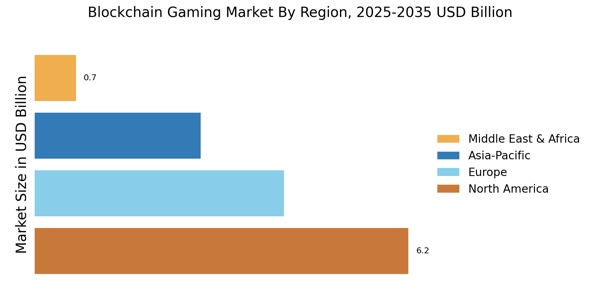Increased Player Ownership
The Blockchain in Gaming Market is witnessing a paradigm shift towards increased player ownership of in-game assets. This trend is largely driven by the implementation of blockchain technology, which allows players to truly own their digital items through non-fungible tokens (NFTs). As players gain ownership, they can trade, sell, or utilize these assets across different games, enhancing their gaming experience. Reports indicate that the market for NFTs in gaming is projected to reach substantial figures, with estimates suggesting a growth rate of over 30% annually. This ownership model not only empowers players but also creates new revenue streams for developers, thereby fostering innovation within the Blockchain in Gaming Market.
Adoption of Smart Contracts
The adoption of smart contracts is a transformative driver in the Blockchain in Gaming Market. Smart contracts automate transactions and enforce agreements without the need for intermediaries, streamlining processes such as asset trading and reward distribution. This technology enhances efficiency and reduces costs for developers and players alike. As more gaming companies integrate smart contracts into their platforms, the potential for innovative gameplay mechanics increases. Market data suggests that the implementation of smart contracts could lead to a reduction in transaction fees by up to 50%, making it more appealing for players to engage in blockchain-based gaming. Consequently, the Blockchain in Gaming Market is poised for substantial growth as smart contracts become more prevalent.
Rise of Play-to-Earn Models
The rise of play-to-earn models is significantly influencing the Blockchain in Gaming Market. These models allow players to earn real-world value through their in-game activities, often facilitated by blockchain technology. Players can earn cryptocurrencies or NFTs as rewards for their gameplay, which can then be traded or sold. This shift towards monetization of gaming experiences is attracting a diverse audience, including those who may not have previously engaged with traditional gaming. Data indicates that play-to-earn games have seen a surge in user adoption, with millions of players participating in these ecosystems. This trend not only enhances player engagement but also contributes to the overall growth of the Blockchain in Gaming Market.
Enhanced Community Engagement
Enhanced community engagement is becoming a pivotal driver in the Blockchain in Gaming Market. Blockchain technology fosters transparency and trust, enabling developers to create more interactive and participatory gaming environments. Players can engage in governance decisions, influencing game development and updates through decentralized autonomous organizations (DAOs). This level of involvement is likely to cultivate a loyal player base, as users feel a sense of ownership and responsibility towards the games they play. Furthermore, community-driven initiatives can lead to innovative gameplay and content creation, further enriching the gaming experience. As a result, the Blockchain in Gaming Market is likely to see increased investment in community engagement strategies.
Interoperability Across Games
Interoperability is emerging as a crucial driver in the Blockchain in Gaming Market. This concept allows players to use their assets across multiple games, creating a seamless gaming experience. By leveraging blockchain technology, developers can create ecosystems where items and characters can be transferred between different games. This interconnectedness is likely to enhance player engagement and retention, as users are incentivized to invest in assets that hold value across various platforms. Market analysis suggests that the demand for interoperable gaming experiences is on the rise, with a significant portion of gamers expressing interest in cross-game asset utilization. Such developments could redefine the landscape of the Blockchain in Gaming Market.



















Leave a Comment